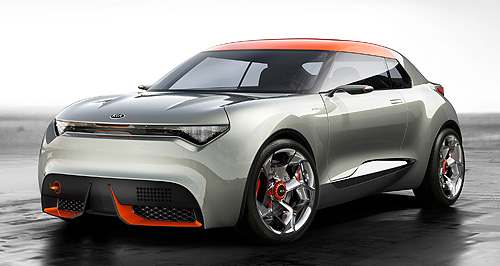Make / Model Search
Future models - Kia - Provo - HybridKia Provo Hybrid tech still years awayReinventing the wheel: The Provo concept car’s rear-drive hybrid technology is not yet ready for buyers, Kia says. Buyers aren’t yet ready for rear-wheel electric motors, Kia says8 Mar 2013 By BYRON MATHIOUDAKIS in GENEVA ELECTRIC motors in the rear wheels of Kia’s show-stealing Provo Concept are still years away from production, the car-maker says. The concept, unveiled in Geneva this week, uses axle-mounted electric motors to drive the rear wheels, while up front it sports a conventional engine driving the front wheels. However, while show cars generally give a hint of technology that is just around the corner, Kia says its unconventional petrol-electric hybrid is still at least five years away from production. According to Dr Joachim Hahn, Kia’s head of the car-maker’s European drivetrain engineering department, this level of hybridisation will likely be most viable when car-makers must meet European legislation that requires a 90 gram per kilometre carbon dioxide emissions average for all the cars they build from 2020. Before that, however, Europe must meet a 130g/km standard combined average figure. “Our general intention is to always look to see which is the best solution for certain problems,” Dr Hahn said. “And with the Provo Concept show car we want to present a little bit about what we are thinking in terms of (hybrid) development. “(But) let’s call it a mid-term solution. “We are still at the beginning of more intelligent hybridisation.” Mr Hahn conceded that the Provo Concept’s complex rear-mounted electric motor solution and subsequent four-wheel drive system would add to the car’s price tag, and on-going running costs. However, he says buyers seeking lower fuel use and fewer emissions - as well as the added traction of all-wheel drive - would justify the extra expense, particularly in a vehicle as attractive as the Kia show car. “Clearly, if you offer a four-wheel-drive instead of a two-wheel-drive solution, of course it is more expensive,” he said. “And running costs are higher… and people start calculating it in terms of annual mileage. “But if you can (also) offer the four-wheel-drive then maybe (for some people) the story becomes quite good.” Kia has sold a 2.4-litre petrol-electric hybrid mid-sized Optima in North America since 2011, while a 2.0-litre version developed specifically for Europe was launched at the Geneva show. Employing a ‘parallel’ series hybrid system and a 70-volt lithium-ion battery, the latter’s official fuel use and carbon dioxide emissions are 5.1L/100km and 119g/km respectively. On the performance front, the 110kW/319Nm 2.0-litre four-cylinder petrol engine is mated to a 35kW electric motor, to help the Optima Hybrid six-speed automatic accelerate to 100km/h from standstill in 9.4 seconds. In contrast, the 124kW/209Nm 2.4-litre version sold in North America employs a 30kW electric motor for a 6.2L/100km fuel use figure in US tests. Kia maintains that neither hybrid version is earmarked for Australia.  Read moreAll motor show Alfa Romeo Alfa Romeo Abarth Abarth Alpine Alpine Alpina Alpina Audi Audi Aston Martin Aston Martin BMW BMW Bentley Bentley Chery Chery Brabham Brabham Chrysler Chrysler Chevrolet Chevrolet Cupra Cupra Citroen Citroen DS DS Dodge Dodge Fiat Fiat Ferrari Ferrari Foton Foton Ford Ford Great Wall Great Wall FPV FPV Haval Haval GWM GWM Honda Honda Holden Holden Hummer Hummer HSV HSV Infiniti Infiniti Hyundai Hyundai Jaguar Jaguar Isuzu Isuzu Kia Kia Jeep Jeep Land Rover Land Rover Lamborghini Lamborghini Lexus Lexus LDV LDV Mahindra Mahindra Lotus Lotus Mazda Mazda Maserati Maserati Mercedes-AMG Mercedes-AMG McLaren McLaren MG MG Mercedes-Benz Mercedes-Benz Mitsubishi Mitsubishi Mini Mini Opel Opel Nissan Nissan Peugeot Peugeot Pagani Pagani Proton Proton Porsche Porsche Renault Renault Ram Ram Rover Rover Rolls-Royce Rolls-Royce Skoda Skoda Saab Saab SsangYong SsangYong Smart Smart Suzuki Suzuki Subaru Subaru Toyota Toyota Tesla Tesla Volvo VolvoMotor industry news |
Click to shareAll motor show Alfa Romeo Alfa Romeo Abarth Abarth Alpine Alpine Alpina Alpina Audi Audi Aston Martin Aston Martin BMW BMW Bentley Bentley Chery Chery Brabham Brabham Chrysler Chrysler Chevrolet Chevrolet Cupra Cupra Citroen Citroen DS DS Dodge Dodge Fiat Fiat Ferrari Ferrari Foton Foton Ford Ford Great Wall Great Wall FPV FPV Haval Haval GWM GWM Honda Honda Holden Holden Hummer Hummer HSV HSV Infiniti Infiniti Hyundai Hyundai Jaguar Jaguar Isuzu Isuzu Kia Kia Jeep Jeep Land Rover Land Rover Lamborghini Lamborghini Lexus Lexus LDV LDV Mahindra Mahindra Lotus Lotus Mazda Mazda Maserati Maserati Mercedes-AMG Mercedes-AMG McLaren McLaren MG MG Mercedes-Benz Mercedes-Benz Mitsubishi Mitsubishi Mini Mini Opel Opel Nissan Nissan Peugeot Peugeot Pagani Pagani Proton Proton Porsche Porsche Renault Renault Ram Ram Rover Rover Rolls-Royce Rolls-Royce Skoda Skoda Saab Saab SsangYong SsangYong Smart Smart Suzuki Suzuki Subaru Subaru Toyota Toyota Tesla Tesla Volvo VolvoMotor industry news |












Facebook Twitter Instagram